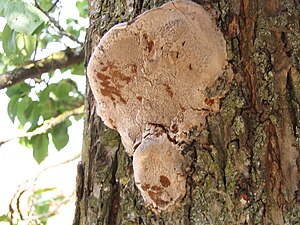Plum fire sponge
| Plum fire sponge | ||||||||||||
|---|---|---|---|---|---|---|---|---|---|---|---|---|

Plum fire sponge ( Phellinus tuberculosus ) |
||||||||||||
| Systematics | ||||||||||||
|
||||||||||||
| Scientific name | ||||||||||||
| Phellinus tuberculosus | ||||||||||||
| ( Baumg. ) Niemelae |
The plum fire sponge ( Phellinus tuberculosus ) is a widespread and common species of fungus from the genus Phellinus .
features
The plum fire sponge forms perennial, about 3–8 cm wide and 1–3 cm thick, console-shaped fruiting bodies, which often run down the underside of the substrate and usually form bulbous, superimposed cap bulges. Fruiting bodies that are completely flat or extremely hat-shaped are less common. Well-formed hat tops are roughly zoned, otherwise uneven, smooth and matt-structured. They are gray to gray-brown in color and can be colored green by algae growing on them. The edge of the fruiting body is bulging and gray to cinnamon brown. The pore area with approx. 4–5 rounded pores per mm² is young and cinnamon-brown in the growth zone, gray-brown in older fruiting bodies. The 2–3 mm long tubes are layered in older fruit bodies. The tough, cork-like trama is colored rusty brown.
ecology
The plum fire sponge lives as a mostly mild parasite or subsequently also saprobiont in and on still attached branches or standing trunks of deciduous trees, mainly on prunus species such as plum and sloe , also peach and blood plum trees often have the inconspicuous fruiting bodies; on street trees even epidemic-like in places. Hazel and hawthorn are much less populated. The fungus causes white rot in the wood . The original biotope of the plum fire sponge are probably hedges, forest edges and sloe bushes. It can also be found in alluvial forests, on the banks of streams and the edges of forest paths. In cultivated land, it can mainly be found in orchards, gardens and parks and can cause damage. The little noticeable perennial fruiting bodies can be found all year round.
distribution
The plum fire sponge is mainly found in the Mediterranean and temperate zones of the Holarctic , in Asia it is found from Asia Minor, the Caucasus and Iran to Siberia, Central Asia and Japan, and in North America from Mexico to Canada. The species is also found in North Africa and the Canary Islands. In Europe, the plum fire sponge occurs from southern and western Europe to the Hebrides and southern Scandinavia, to the east it can be found as far as Hungary, Belarus and western Ukraine, and individual occurrences exist as far as Central Russia and the Urals. In Germany the species is relatively dense everywhere.
meaning
As a white rotten pathogen, it destroys its host over time, but it is only slightly aggressive, and infested trees can usually live on for many years.
swell
- German Josef Krieglsteiner (Ed.): The large mushrooms of Baden-Württemberg . Volume 1: General Part. Stand mushrooms: jelly, bark, prick and pore mushrooms. Ulmer, Stuttgart 2000, ISBN 3-8001-3528-0 .
- Josef Breitenbach, Fred Kränzlin (Ed.): Mushrooms of Switzerland. Contribution to knowledge of the fungal flora in Switzerland. Volume 2: Heterobasidiomycetes (gelatinous mushrooms), Aphyllophorales (non-leaf mushrooms), Gastromycetes (belly mushrooms). Mykologia, Luzern 1986, ISBN 3-85604-020-X .
